Connect With Us
Blog
Developmental Milestones and Children’s Feet

Children's feet go through remarkable transformations, shifting from their spongy, soft state in the pre-crawling phase, to rapidly growing during their initial years. As children move into the crawling stage, their feet become more delicate, and soft, protective footwear is suggested. When they take their first steps, the need for proper walking shoes arises, given the fast bone development. Entering pre-school, kids are more active, necessitating diverse shoe styles. By school age, feet have evolved significantly, and shoes should be sought for increased activity. To ensure the well-being of your child's developing feet and proper shoes for each milestone achieved, it is suggested that you make an appointment with a podiatrist for guidance on proper foot care that will benefit them throughout life.
Making sure that your children maintain good foot health is very important as they grow. If you have any questions, contact one of our podiatrists of The Podiatry Center, PC. Our doctors can provide the care you need to keep you pain-free and on your feet.
Keeping Children's Feet Healthy
Having healthy feet during childhood can help prevent medical problems later in life, namely in the back and legs. As children grow, their feet require different types of care. Here are some things to consider...
Although babies do not walk yet, it is still very important to take care of their feet.
Avoid putting tight shoes or socks on his or her feet.
Allow the baby to stretch and kick his or her feet to feel comfortable.
As a toddler, kids are now on the move and begin to develop differently. At this age, toddlers are getting a feel for walking, so don’t be alarmed if your toddler is unsteady or ‘walks funny’.
As your child gets older, it is important to teach them how to take care of their feet.
Show them proper hygiene to prevent infections such as fungus.
Be watchful for any pain or injury.
Have all injuries checked by a doctor as soon as possible.
Comfortable, protective shoes should always be worn, especially at play.
If you have any questions please feel free to contact our office located in Millburn, NJ . We offer the newest diagnostic and treatment technologies for all your foot and ankle needs.
Heel Pain Can Be Treated!
Treatment for Broken Ankles

Broken ankles, also known as ankle fractures, can vary from minor hairline fractures to severe, multiple fractures. They occur when one or more of the bones that make up the ankle joint are broken. The type of fracture often determines the treatment needed. Simple fractures may need immobilization with a cast or splint to ensure proper alignment during healing. More complex fractures, particularly those where the bones are out of place or the ankle joint is unstable, may require surgery. The surgical intervention aims to realign the bones and secure them in place with screws, plates, or pins. During post-surgery, the ankle is generally immobilized, and weight-bearing may be restricted for a certain period. If you have broken your ankle, it is strongly suggested that you make an appointment with a podiatrist for a proper diagnosis and prompt treatment to reduce the risk of complications.
Broken ankles need immediate treatment. If you are seeking treatment, contact one of our podiatrists from The Podiatry Center, PC. Our doctors can provide the care you need to keep you pain-free and on your feet.
Broken Ankles
A broken ankle is experienced when a person fractures their tibia or fibula in the lower leg and ankle area. Both of these bones are attached at the bottom of the leg and combine to form what we know to be our ankle.
When a physician is referring to a break of the ankle, he or she is usually referring to a break in the area where the tibia and fibula are joined to create our ankle joint. Ankles are more prone to fractures because the ankle is an area that suffers a lot of pressure and stress. There are some obvious signs when a person experiences a fractured ankle, and the following symptoms may be present.
Symptoms of a Fractured Ankle
- Excessive pain when the area is touched or when any pressure is placed on the ankle
- Swelling around the area
- Bruising of the area
- Area appears to be deformed
If you suspect an ankle fracture, it is recommended to seek treatment as soon as possible. The sooner you have your podiatrist diagnose the fracture, the quicker you’ll be on the way towards recovery.
If you have any questions, please feel free to contact our office located in Millburn, NJ . We offer the newest diagnostic and treatment technologies for all your foot care needs.
Causes and Treatment of Heel Fissures
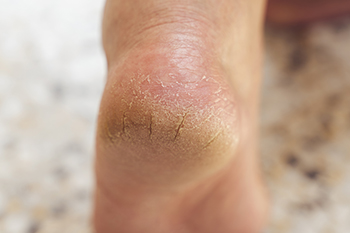
Heel fissures, which are cracks in the skin on your heels, can be more than just a cosmetic concern. Heel fissures often lead to discomfort and may even pose a risk of painful infections and skin damage. Diabetics are particularly susceptible to heel fissures because of the effects of damaged nerves in the feet that hinder natural moisturization. Dry skin is the most common cause associated with heel fissures, but various factors may contribute to their formation. Among them are eczema, athlete's foot, and environmental conditions. Additionally, medical conditions such as hypothyroidism, psoriasis, and rheumatoid arthritis can be factors. Any condition that results in the thickening of tissue or affects sweat production can heighten the risk. To tackle heel fissures, consider applying thick moisturizers twice a day. For more stubborn cases, a podiatrist may prescribe the use of products containing alpha hydroxy acids, salicylic acids, or urea to help shed dead skin cells. Anyone with heel fissures is wise to take this condition seriously. For help, it is suggested that you make an appointment with a podiatrist for an exam and appropriate treatment options.
Cracked heels are unsightly and can cause further damage to your shoes and feet. If you have any concerns, contact one of our podiatrists from The Podiatry Center, PC. Our doctors can provide the care you need to keep you pain-free and on your feet.
Cracked Heels
Cracked heels appear unappealing and can make it harder for you walk around in sandals. Aside from looking unpleasant, cracked heels can also tear stockings, socks, and wear out your shoes. There are several methods to help restore a cracked heel and prevent further damage.
How Do You Get Them?
Dry skin is the number one culprit in creating cracked heels. Many athletes, walkers, joggers, and even swimmers suffer from cracked heels. Age and skin oil production play a role to getting cracked heels as well.
Promote Healing
Over the counter medicines can help, especially for those that need instant relief or who suffer from chronic dry feet.
Wear Socks – Wearing socks with medicated creams helps lock in moisture.
Moisturizers – Applying both day and night will help alleviate dryness which causes cracking.
Pumice Stones – These exfoliate and remove dead skin, which allows for smoother moisturizer application and better absorption into the skin.
Change in Diet
Eating healthy with a well-balanced diet will give the skin a fresh and radiant look. Your body responds to the kinds of food you ingest. Omega-3 fatty acids and zinc supplements can also revitalize skin tissue.
Most importantly, seek professional help if unsure how to proceed in treating cracked heels. A podiatrist will help you with any questions or information needed.
If you have any questions, please feel free to contact our office located in Millburn, NJ . We offer the newest diagnostic and treatment technologies for all your foot care needs.
Plantar Warts Can Be Treated!
How Osteoarthritis Can Affect the Ankle
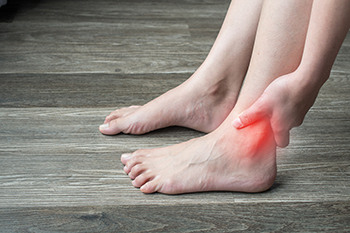
Osteoarthritis, or OA, which is often associated with aging and wear-and-tear, isn't limited to just the knees and hips. It can also affect the ankle joint, causing pain and mobility issues. Osteoarthritis in the ankle is a chronic condition that develops when the protective cartilage that cushions the bones begins to deteriorate. OA can occur at any time of life, but it is most common in older adults. Being overweight adds stress to your ankles and fat cells produce proteins that may make the condition worse. Any ankle injury, even one that happened years ago, can lead to osteoarthritis. Symptoms include pain, stiffness, swelling, and a reduced range of motion, which can significantly affect your daily life. Even simple tasks like walking and climbing stairs can become challenging. Several factors can contribute to ankle osteoarthritis, including previous injuries, genetics, and obesity. Treatment options include medication, physical therapy, orthotic devices, and in some cases, surgery. Osteoarthritis is a progressive disease, and for that reason managing it requires a comprehensive approach to reduce pain and maintain mobility. It's suggested that you make an appointment with a podiatrist if you suspect osteoarthritis is affecting your ankles.
Arthritis can be a difficult condition to live with. If you are seeking treatment, contact one of our podiatrists from The Podiatry Center, PC. Our doctors can provide the care you need to keep you pain-free and on your feet.
Arthritic Foot Care
Arthritis is a term that is commonly used to describe joint pain. The condition itself can occur to anyone of any age, race, or gender, and there are over 100 types of it. Nevertheless, arthritis is more commonly found in women compared to men, and it is also more prevalent in those who are overweight. The causes of arthritis vary depending on which type of arthritis you have. Osteoarthritis for example, is often caused by injury, while rheumatoid arthritis is caused by a misdirected immune system.
Symptoms
- Swelling
- Pain
- Stiffness
- Decreased Range of Motion
Arthritic symptoms range in severity, and they may come and go. Some symptoms stay the same for several years but could potentially get worse with time. Severe cases of arthritis can prevent its sufferers from performing daily activities and make walking difficult.
Risk Factors
- Occupation – Occupations requiring repetitive knee movements have been linked to osteoarthritis
- Obesity – Excess weight can contribute to osteoarthritis development
- Infection – Microbial agents can infect the joints and trigger arthritis
- Joint Injuries – Damage to joints may lead to osteoarthritis
- Age – Risk increases with age
- Gender –Most types are more common in women
- Genetics – Arthritis can be hereditary
If you suspect your arthritis is affecting your feet, it is crucial that you see a podiatrist immediately. Your doctor will be able to address your specific case and help you decide which treatment method is best for you.
If you have any questions, please feel free to contact our office located in Millburn, NJ . We offer the newest diagnostic and treatment technologies for all your foot care needs.
Total Contact Cast Helps With Foot Ulcers
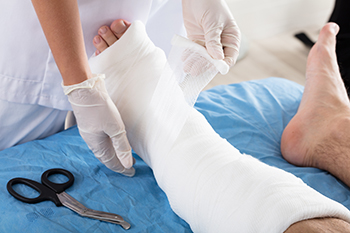
Foot ulcers can be a debilitating condition, common among individuals with diabetes. An effective treatment option in managing foot ulcers is a total contact cast. A podiatrist can apply this device and it consists of a custom-made cast that snugly conforms to the shape of your foot and ankle. The cast ensures pressure redistribution across the ulcer, reducing the risk of further tissue damage and accelerating the healing process. It also immobilizes the foot, preventing excessive movement that can worsen ulcers and hinder recovery. Further, a total contact cast acts as a protective shield, safeguarding your foot from external factors and reducing the risk of infection or other complications. Studies show that this type of cast can speed up ulcer healing compared with more conventional dressings and offloading techniques. This is due to a customized fit that maximizes both comfort and effectiveness. To determine whether a total contact cast is suitable for your condition, it is suggested that you make an appointment with a podiatrist, who is specifically trained to manage diabetic foot ulcers.
Diabetic foot care is important in preventing foot ailments such as ulcers. If you are suffering from diabetes or have any other concerns about your feet, contact one of our podiatrists from The Podiatry Center, PC. Our doctors can provide the care you need to keep you pain-free and on your feet.
Diabetic Foot Care
Diabetes affects millions of people every year. The condition can damage blood vessels in many parts of the body, especially the feet. Because of this, taking care of your feet is essential if you have diabetes, and having a podiatrist help monitor your foot health is highly recommended.
The Importance of Caring for Your Feet
- Routinely inspect your feet for bruises or sores.
- Wear socks that fit your feet comfortably.
- Wear comfortable shoes that provide adequate support.
Patients with diabetes should have their doctor monitor their blood levels, as blood sugar levels play such a huge role in diabetic care. Monitoring these levels on a regular basis is highly advised.
It is always best to inform your healthcare professional of any concerns you may have regarding your feet, especially for diabetic patients. Early treatment and routine foot examinations are keys to maintaining proper health, especially because severe complications can arise if proper treatment is not applied.
If you have any questions please feel free to contact our office located in Millburn, NJ . We offer the newest diagnostic and treatment technologies for all your foot and ankle needs.
Arthritis Can Cause Pain in the Feet and Ankles
Bunion Treatment

Bunions are a common foot problem that can be painful and frustrating. A bunion can occur when the bone or tissue at the base of the big toe moves out of place, causing discomfort, swelling, and difficulty in finding comfortable shoes. While bunions cannot be reversed without surgery, there are effective non-surgical treatments that can help to reduce pain and improve foot health. Bunions can be caused by factors such as wearing poorly fitting footwear, foot weaknesses, and genetics. Some individuals are more at risk, and people with certain foot types or who wear tight shoes may be affected. Non-surgical treatments for bunions include wearing shoes with a wide toe box and performing foot exercises to strengthen and increase flexibility. Additionally, using orthotics or bunion pads may help provide moderate relief. Surgery is considered to be a last resort for severe cases of bunions when non-surgical treatments fail to provide relief. Various surgical procedures can correct bunions, but there is a risk of recurrence. Implementing lifestyle changes such as choosing appropriate footwear, maintaining a healthy weight, practicing foot exercises, and avoiding high-impact activities can reduce the risk of developing bunions. If you experience discomfort from a bunion, it is suggested that you make an appointment with a podiatrist for a treatment plan that is right for you.
If you are suffering from bunion pain, contact one of our podiatrists of The Podiatry Center, PC. Our doctors can provide the care you need to keep you pain-free and on your feet.
What Is a Bunion?
Bunions are painful bony bumps that usually develop on the inside of the foot at the joint of the big toe. As the deformity increases over time, it may become painful to walk and wear shoes. Women are more likely to exacerbate existing bunions since they often wear tight, narrow shoes that shift their toes together. Bunion pain can be relieved by wearing wider shoes with enough room for the toes.
Causes
- Genetics – some people inherit feet that are more prone to bunion development
- Inflammatory Conditions - rheumatoid arthritis and polio may cause bunion development
Symptoms
- Redness and inflammation
- Pain and tenderness
- Callus or corns on the bump
- Restricted motion in the big toe
In order to diagnose your bunion, your podiatrist may ask about your medical history, symptoms, and general health. Your doctor might also order an x-ray to take a closer look at your feet. Nonsurgical treatment options include orthotics, padding, icing, changes in footwear, and medication. If nonsurgical treatments don’t alleviate your bunion pain, surgery may be necessary.
If you have any questions, please feel free to contact our office located in Millburn, NJ . We offer the newest diagnostic and treatment technologies for all your foot care needs.
Foot Care and Falls Prevention
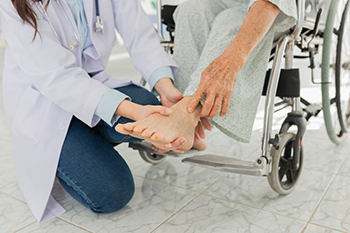
When considering the well-being of elderly loved ones, it is essential not to overlook the health of their feet, as they play a vital role in supporting their mobility. Foot problems among seniors are common and often associated with weakness, altered gait, and balance difficulties, which can increase the risk of falls. Various foot issues can affect older individuals and can include corns, calluses, and toenail disorders. Additionally, bunions and deformities such as hammertoe and claw toe may develop. Loss of fat pads and connective tissue disorders can also lead to discomfort. Poor circulation and systemic conditions, such as diabetes and arthritis, can further compound foot problems. Proper elderly foot care involves regular checks for changes in foot health, maintaining cleanliness, and ensuring proper footwear fit. Orthotics can help alleviate foot pain and reduce fall risks in the elderly as well. If you are elderly or taking care of a senior, it is suggested that you make an appointment with a podiatrist to help maintain regular foot care, in addition to providing advice on effective fall prevention techniques.
Proper foot care is something many older adults forget to consider. If you have any concerns about your feet and ankles, contact one of our podiatrists from The Podiatry Center, PC. Our doctors can provide the care you need to keep you pain-free and on your feet.
The Elderly and Their Feet
As we age we start to notice many changes in our body, but the elder population may not notice them right away. Medical conditions may prevent the elderly to take notice of their foot health right away. Poor vision is a lead contributor to not taking action for the elderly.
Common Conditions
- Neuropathy – can reduce feeling in the feet and can hide many life-threatening medical conditions.
- Reduced flexibility – prevents the ability of proper toenail trimming, and foot cleaning. If left untreated, it may lead to further medical issues.
- Foot sores – amongst the older population can be serious before they are discovered. Some of the problematic conditions they may face are:
- Gouging toenails affecting nearby toe
- Shoes that don’t fit properly
- Pressure sores
- Loss of circulation in legs & feet
- Edema & swelling of feet and ankles
Susceptible Infections
Diabetes and poor circulation can cause general loss of sensitivity over the years, turning a simple cut into a serious issue.
If you have any questions please feel free to contact our office located in Millburn, NJ . We offer the newest diagnostic and treatment technologies for all your foot and ankle needs.
More...
Gout Pain Can Be Managed
Healing From a Broken Toe
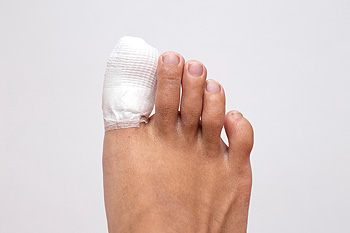
A broken toe can be a painful and frustrating experience, but with patience and proper care, it can mend successfully. The first step in healing a broken toe is to seek medical attention from a podiatrist for an accurate diagnosis and to rule out any complications. Once diagnosed, the primary focus is on rest and protection. This often involves wearing a splint, cast, or buddy taping, which is taping the broken toe to the toe next to it. This is generally successful in immobilizing the injured area. Elevating the foot can help reduce swelling, while taking over-the-counter pain relievers can manage discomfort. Avoid putting weight on the affected toe and opt for comfortable, supportive footwear. Healing times can vary but typically range from a few weeks to a couple of months. As your toe begins to mend, performing several range of motion exercises that can aid in recovery is beneficial. If you have broken your toe, it is suggested that you are under the care of a podiatrist who can guide you toward the best treatment methods for you.
A broken toe can be very painful and lead to complications if not properly fixed. If you have any concerns about your feet, contact one of our podiatrists from The Podiatry Center, PC. Our doctors will treat your foot and ankle needs.
What to Know About a Broken Toe
Although most people try to avoid foot trauma such as banging, stubbing, or dropping heavy objects on their feet, the unfortunate fact is that it is a common occurrence. Given the fact that toes are positioned in front of the feet, they typically sustain the brunt of such trauma. When trauma occurs to a toe, the result can be a painful break (fracture).
Symptoms of a Broken Toe
- Throbbing pain
- Swelling
- Bruising on the skin and toenail
- The inability to move the toe
- Toe appears crooked or disfigured
- Tingling or numbness in the toe
Generally, it is best to stay off of the injured toe with the affected foot elevated.
Severe toe fractures may be treated with a splint, cast, and in some cases, minor surgery. Due to its position and the pressure it endures with daily activity, future complications can occur if the big toe is not properly treated.
If you have any questions please feel free to contact our office located in Millburn, NJ . We offer the newest diagnostic and treatment technologies for all your foot and ankle needs.
Treatment Options for Flat Feet

Flat feet is a condition where the arch of the foot is either too low or nonexistent. As a rule, flat feet are rarely considered to be medically serious. However, flat feet can sometimes lead to discomfort or complications, and some type of treatment may be necessary. If you are experiencing pain around the ankle or aching in the arch of the foot, it may be time to consider treatment. Additionally, if you notice that your shoes are wearing out quickly, it could be a sign that your flat feet are causing undue stress on your footwear. Non-surgical treatment includes changing footwear, investing in orthotic inserts for improved arch support, and performing certain exercises to improve the strength and flexibility of the foot muscles. These can potentially reduce pain and discomfort. Prescription painkillers may be recommended to manage pain and any stiffness associated with flat feet. When other treatments have failed or if there's a structural issue with the bones, tissues, or muscles in the feet, surgery may be considered as a last resort. For guidance about treatment options for flat feet, it is suggested that you consult a podiatrist.
Flatfoot is a condition many people suffer from. If you have flat feet, contact one of our podiatrists from The Podiatry Center, PC. Our doctors will treat your foot and ankle needs.
What Are Flat Feet?
Flatfoot is a condition in which the arch of the foot is depressed and the sole of the foot is almost completely in contact with the ground. About 20-30% of the population generally has flat feet because their arches never formed during growth.
Conditions & Problems:
Having flat feet makes it difficult to run or walk because of the stress placed on the ankles.
Alignment – The general alignment of your legs can be disrupted, because the ankles move inward which can cause major discomfort.
Knees – If you have complications with your knees, flat feet can be a contributor to arthritis in that area.
Symptoms
- Pain around the heel or arch area
- Trouble standing on the tip toe
- Swelling around the inside of the ankle
- Flat look to one or both feet
- Having your shoes feel uneven when worn
Treatment
If you are experiencing pain and stress on the foot you may weaken the posterior tibial tendon, which runs around the inside of the ankle.
If you have any questions please feel free to contact our office located in Millburn, NJ . We offer the newest diagnostic and treatment technologies for all your foot and ankle needs.
Are Bunions Affecting Your Everyday Life?
Blog Archives
- June 2025
- May 2025
- April 2025
- March 2025
- February 2025
- January 2025
- December 2024
- November 2024
- October 2024
- September 2024
- August 2024
- July 2024
- June 2024
- May 2024
- April 2024
- March 2024
- February 2024
- January 2024
- December 2023
- November 2023
- October 2023
- September 2023
- August 2023
- July 2023
- June 2023
- May 2023
- April 2023
- March 2023
- February 2023
- January 2023
- December 2022
- November 2022
- October 2022
- September 2022
- August 2022
- July 2022
- June 2022
- May 2022
- April 2022
- March 2022
- February 2022
- January 2022
- December 2021
- November 2021
- October 2021
- September 2021
- August 2021
- July 2021
- June 2021
- May 2021
- April 2021
- March 2021
- February 2021
- January 2021
- December 2020
- November 2020
- October 2020
- September 2020
- August 2020
- July 2020
- June 2020
- May 2020
- April 2020
- March 2020
- February 2020
- January 2020
- December 2019
- November 2019
- October 2019
- September 2019
- August 2019
- July 2019
- June 2019
- May 2019
- April 2019
- March 2019
- February 2019
- January 2019
- December 2018
- November 2018
- October 2018
- September 2018
- August 2018
- July 2018
- June 2018
- May 2018
- April 2018
- March 2018
- February 2018
- January 2018
- December 2017
- November 2017
- October 2017
- September 2017
- August 2017
- July 2017
- June 2017
- May 2017
- April 2017
- March 2017
- February 2017
- January 2017
- December 2016
- November 2016
- October 2016
- September 2016
- August 2016
- July 2016
- June 2016
- May 2016
- April 2016
- March 2016
- February 2016
- January 2016
- December 2015
- November 2015
- October 2015
- September 2015
- August 2015
- July 2015
- June 2015
- May 2015
- January 2014
- December 2013
- November 2013
- October 2013
- September 2013
- August 2013
- July 2013
- June 2013
- May 2013
- April 2013
- March 2013
- February 2013
- January 2013
- December 2012
- November 2012
- October 2012
- September 2012
- August 2012
- July 2012
- June 2012





